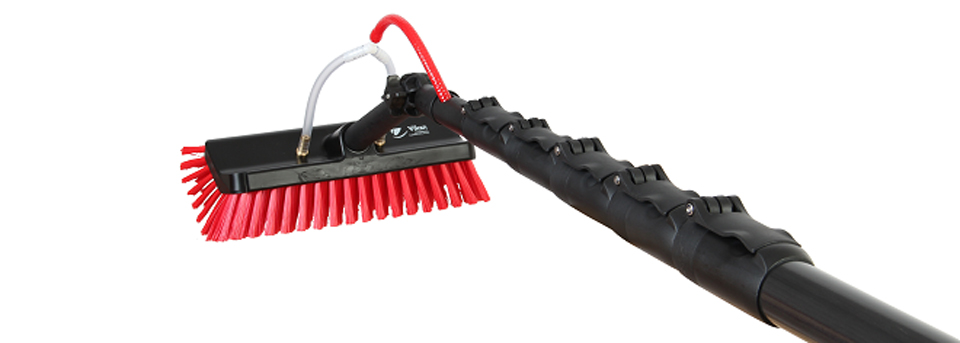
The different kinds of water fed pole available on the market can be baffling, particularly if you are new to using the pure water system. In this post, we aim to help explain the different types of water fed pole and help you to identify which might be best suited to the needs of your window cleaning business.
Water fed poles can be broken into their type and material. We’ll start with type:
Telescopic
By far the most common type of water fed poles in use, telescopic poles are made up of a series of extendable pole sections that compress and extend as one single unit. They offer maximum convenience, allowing for constant height adjustments to be made with little effort. However, you are always carrying and lifting all sections of the pole even when they are not needed. Enter modular poles.
Modular
Modular poles are made up of a series of separate sections that are manually added and removed depending on the height required. Whilst more time consuming to use than telescopic poles, they offer the benefit of being lighter when set at the equivalent height – only the sections required are attached to the pole, and you don’t have the added weight of telescopic clamps are not required. Generally, modular poles are most suitable where window cleaners are consistently cleaning at the same height for an extended period of time, making them most commonly used in commercial window cleaning environments.
Both types of water fed pole are available in a range of materials:
Fibreglass (or Glass Fibre)
Optimal Height Range: 0-30 feet
Fibreglass poles are the most common entry level choice. They offer excellent value for money and good performance up to around 25-30 feet extension. Above 30-feet, fibreglass poles start to get heavy and do not offer enough rigidity which results in unhelpful flex – making the poles unwieldy and meaning energy you put in on the ground is lost on its way to the window. Depending on the quality of the pole and outer coating of the fibreglass, they will show signs of wear fairly quickly with heavy use, which can result in thinning sections prone to shattering, and irritating splinters for users. To summarize:
Pros: Excellent value & perform well below 30ft, ideal for light to medium residential use
Cons: Heavy and overly-flexible above 30ft, less durable than other material types
Carbon Fibre
Optimal Height Range: 0-70+ feet
Carbon fibre poles are harder wearing, lighter, more rigid and substantially more expensive than their fibreglass counterparts. It’s for these reasons that carbon fibre poles are the default choice for high-reach, commercial applications of 40-feet or more. Of course, they also work exceptionally at lower heights as well, but their expense often means that a compromise is chosen in favour.
Pros: Light & rigid, ideal for higher usage, much more hardwearing than fibreglass poles
Cons: More expensive meaning they are not always viable for lower heights
Hybrid (or Carbon Composite)
Optimal Height Range: 0-45 feet
Hybrid water fed poles strive to offer the best of both worlds – the value of fibreglass poles with the hard-wearing, rigid and lightweight facets of carbon fibre poles. This “mix” is most commonly achieved by manufacturing the pole sections out of a composite material containing carbon fibre (carbon composite). The result is a water fed pole that is cheaper than carbon fibre but lighter and more rigid than a fibreglass pole. Hybrid water fed pole prices have lowered in recent years as pole manufacturers continue to refine their products and develop new hybrid technology, meaning they are becoming a viable entry-level alternative to fibreglass. However, they are still not lightweight enough for high-access, commercial applications over 45-feet.
Pros: Excellent value for performance, better than fibreglass, can compete with carbon fibre at lower heights
Cons: Not as light as carbon fibre, can be heavy over 45-feet
Aluminium
Optimal Height Range: 0-30 feet
Originally the go to material, aluminium water fed poles are becoming harder to find. However, there are still several on the the market that can make viable, entry level residential poles at very reasonable prices. Made from aircraft grade aluminium, these poles are more rigid and far more hardwearing than fibreglass, but they are also heavier, and above 30-feet they they tend to be too heavy. Another major disadvantage is that they conduct electricity, making them far less safe than other types of pole around overhead power lines.
Pros: Excellent value, more rigid and hard-wearing than fibreglass and other materials
Cons: Heavier than most other materials, conduct electricity

